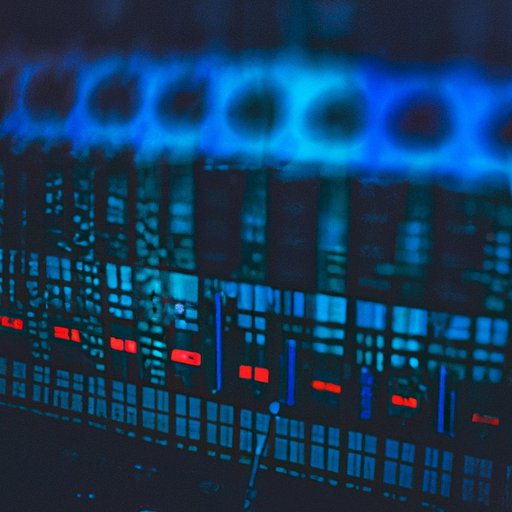Introduction
Computer science has become an integral part of modern music production. From understanding audio recording and mixing, to exploring synthesizers and samplers, to analyzing algorithms and their role in music composition, computer science has revolutionized the way music is created, performed, and heard. In this article, we will explore how computer science is used in music, and discuss the potential of artificial intelligence for music creation.

Exploring the Use of Computer Science in Music Production
The use of computer science in music production begins with understanding audio recording and mixing. Audio recording involves capturing sound waves using microphones, which are then converted into digital signals that can be manipulated by a computer. Mixing is the process of combining multiple audio tracks together, adjusting levels, applying effects, and more. Digital signal processing (DSP) is also used to shape and manipulate audio signals, allowing for further control over the sound.
Synthesizers and samplers are also used in music production. Synthesizers are devices that generate sounds electronically, while samplers are devices that record and store samples of sound. Both of these tools allow musicians to create unique and interesting sounds that would otherwise be impossible to produce.
Understanding Algorithms and their Role in Music Composition
Algorithms are used in a variety of ways in music composition. Generative music is a form of algorithmic composition in which compositional rules are used to generate musical material. Procedural music takes this one step further by using algorithms to generate entire compositions. Algorithmic composition is the process of using computer algorithms to compose music.
In addition to composition, algorithms are also used to analyze music. For example, algorithms can be used to identify patterns in melodies or chord progressions, or to detect similarities between different pieces of music. This type of analysis can be used to inform the composition process, or to identify copyright infringements.
Analyzing Digital Audio Signal Processing and its Impact on Music
Digital audio signal processing (DASP) is used to shape and manipulate audio signals. Equalization and filtering are two common techniques used in DASP. Equalization is used to adjust the frequency response of an audio signal, while filtering is used to remove unwanted frequencies. Compression and dynamic range are also used to control the dynamics of an audio signal.
Reverberation and delay effects are also used to add ambience and depth to an audio signal. These effects simulate the sound of reverberation in a physical space, such as a concert hall or recording studio. Reverb and delay can be used to make a recording sound more natural, or to create a unique soundscape.

Examining the Benefits of Machine Learning for Music Generation
Machine learning is being used to create music in a variety of ways. Neural networks are being used to generate melodies and harmonies, while generative adversarial networks (GANs) are being used to create entire pieces of music. Deep learning is also being used to create complex sounds and textures that would otherwise be difficult to program.
Machine learning can also be used to analyze existing music and identify patterns or similarities. This type of analysis can be used to create personalized playlists, or to suggest similar songs based on user preferences.

Investigating the Use of Computer Vision in Music Visualization
Computer vision is being used to create visualizations of music. Image recognition can be used to detect objects in photos or videos, and motion tracking can be used to track movement in video footage. Video synthesis is also being used to generate visuals based on audio signals.
These techniques can be used to create interactive visuals for live performances, or to create stunning visuals for music videos. They can also be used to analyze music videos and identify patterns or similarities.
Discussing the Potential of Artificial Intelligence for Music Creation
Artificial intelligence is being used to create music in a variety of ways. Natural language processing is being used to generate lyrics, while creative AI agents are being used to compose entire songs. Autonomous music systems are also being developed, which can generate music without human input.
AI is also being used to analyze existing music and identify patterns or similarities. This type of analysis can be used to create personalized playlists, or to suggest similar songs based on user preferences.
Conclusion
Computer science has revolutionized the music industry, from audio recording and digital signal processing to algorithmic composition and machine learning-generated music. This article has explored the various ways computer science is used in music, from understanding audio recording and mixing, to exploring synthesizers and samplers, to analyzing algorithms and their role in music composition, to examining digital audio signal processing and its impact on music, to examining the benefits of machine learning for music generation, to investigating the use of computer vision in music visualization, to discussing the potential of artificial intelligence for music creation.
(Note: Is this article not meeting your expectations? Do you have knowledge or insights to share? Unlock new opportunities and expand your reach by joining our authors team. Click Registration to join us and share your expertise with our readers.)
